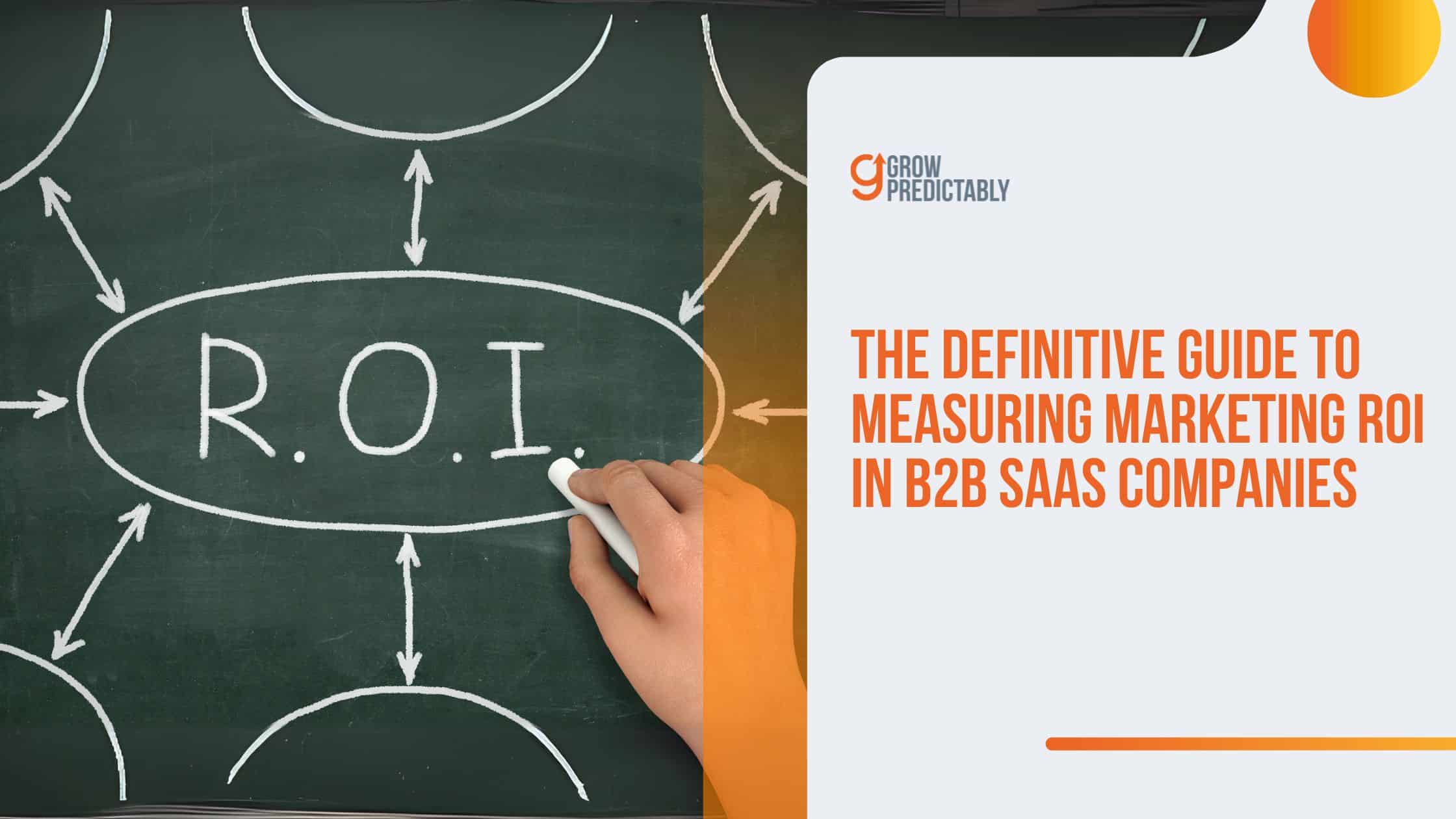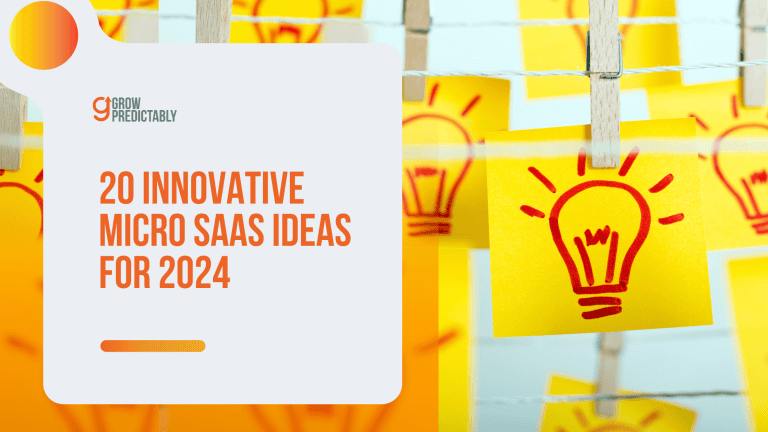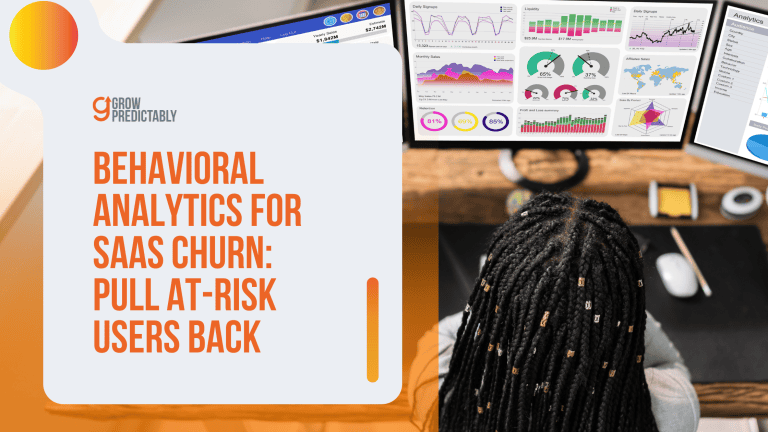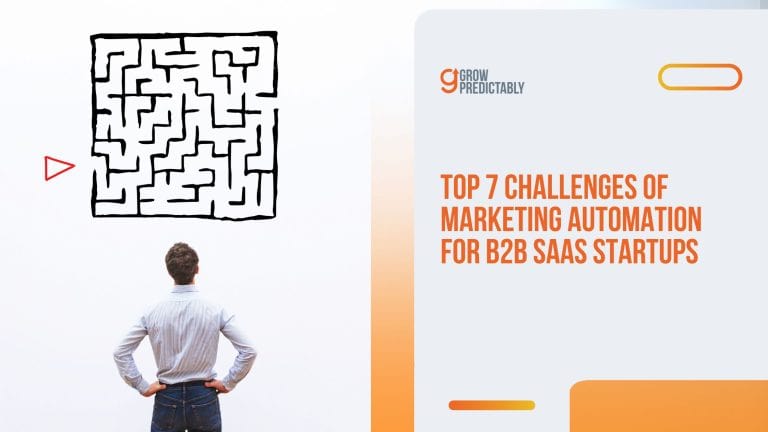The Definitive Guide to Measuring Marketing ROI in B2B SaaS Companies
Marketers throw billions at campaigns every year—but what happens when they can’t track results?
When it comes to measuring marketing ROI in B2B SaaS companies, the stakes are higher than ever.
Because in SaaS, ROI isn’t just about dollars.
It’s about customer retention, upgrades, and churn—numbers that can crush or catapult growth.
The good news?
You don’t need a huge budget or complicated tools to crack the ROI code!
Want to know the one framework that can completely change how you measure success?
Let’s dig in!
Understanding Marketing ROI in SaaS
Every successful SaaS business operates on a fundamental truth: understanding and optimizing your SaaS marketing ROI isn’t just about tracking numbers – it’s about building a sustainable engine for growth.
Calculating marketing ROI involves measuring the effectiveness and financial return on various marketing strategies, such as email marketing, SEO, PPC, content marketing, and social media.
The metrics that drive SaaS success follow a precise mathematical formula, where each component directly impacts your company’s trajectory.
Let’s break down these critical components with surgical precision.
Basics of Marketing ROI in SaaS
SaaS marketing ROI operates on a fundamentally different model than traditional businesses because of its subscription-based nature.
The complexity comes from the compounding effect of recurring revenue streams and the delayed nature of realizing your full return.
Your true marketing ROI in SaaS is determined by a matrix of interconnected metrics that create a comprehensive picture of business health:
- Recurring Revenue Multipliers: Each customer represents not just their initial purchase, but a stream of predictable future income
- Cost Structure Analysis: Understanding the fixed vs variable costs associated with serving each additional customer
- Scale Economics: The decreasing marginal cost of acquiring and serving customers as your business grows
- Revenue Expansion Opportunities: Systematic approaches to growing account value through upsells and cross-sells
- Content Marketing: The role of content marketing in driving lead generation and conversions
- Content Marketing ROI: Evaluating the effectiveness of content marketing strategies and their indirect influence on revenue generation
Key Terms
These metrics form the backbone of SaaS marketing ROI calculation.
According to OpenView’s 2024 SaaS Benchmarks, top-performing companies obsessively track these metrics and optimize them relentlessly:
- Customer Lifetime Value (LTV): This metric encompasses the total economic value a customer brings over their entire relationship with your company. The calculation must include expansion revenue, service costs, and support overhead.
- Customer Acquisition Cost (CAC): A comprehensive measurement of all resources expended to acquire a customer. This includes direct marketing spend, sales team costs, tools, and overhead allocated to acquisition efforts.
- Churn Rate: The systematic measurement of customer loss over time, including analysis of both logo churn and revenue churn. Understanding the patterns and leading indicators of churn enables proactive retention strategies.
Challenges in B2B SaaS
B2B SaaS companies face unique obstacles in measuring and optimizing their SaaS marketing ROI.
These challenges require specific strategies and systems:
- Enterprise Deal Complexity: The multi-layered nature of B2B sales requires sophisticated attribution modeling
- Value Realization Timelines: The gap between purchase and value realization demands precise tracking systems
- Stakeholder Management: Multiple decision-makers affect both customer acquisition cost and retention metrics
- Contract Value Evolution: Changes in seat counts and feature usage impact lifetime value calculations
- Marketing Channels: The need to analyze different channels individually to understand their contribution to lead generation and overall business impact
Importance of Measuring ROI
Marketing ROI measurement in SaaS transcends simple profit tracking.
Key performance indicators (KPIs) should be closely aligned with marketing goals to effectively measure the success of marketing campaigns.
According to Bessemer Venture Partners’ State of the Cloud 2024, companies with sophisticated marketing ROI tracking systems demonstrate:
- 40% higher growth rates
- 50% lower customer acquisition costs
- 35% higher customer retention rates
- 2.5x higher valuation multiples
Key Metrics and KPIs: Mastering the Customer Value Journey in B2B SaaS
The Customer Value Journey (CVJ) framework can transform how your B2B SaaS company grows revenue by mapping the exact path from stranger to raving fan.
It’s not just tracking numbers – it’s understanding the precise moments that turn casual visitors into customers who can’t stop talking about your product.

Understanding the return on investment for each marketing campaign is crucial for optimizing budget allocation and overall marketing strategy success.
When you master CVJ, you start seeing patterns in customer behavior that directly impact your bottom line.
The Customer Value Journey Breakdown
Your metrics are worthless unless tied to specific stages of customer progression.
Each stage of the CVJ represents a critical conversion point where prospects either advance or drop off.
Here’s the exact blueprint for measuring success at each stage:
Aware Stage
The foundation of your growth engine starts with precise measurement of awareness metrics.
These numbers reveal the true reach of your brand:
- Website Analytics Beyond Vanity Metrics: Track unique visitors with intent signals like scroll depth and exit pages to identify serious prospects versus casual browsers
- Competitive Share of Voice: Monitor branded search volume growth and direct traffic increases as indicators of market penetration
- Attribution Modeling: Implement multi-touch attribution to understand which marketing channels drive qualified traffic that converts, not just raw visitor numbers
Engage Stage
Engagement metrics reveal whether your content and messaging resonate with your target audience:
- Content Performance Analytics: Track advanced engagement metrics like average reading time, scroll depth, and return visitor rates to measure true content impact
- Interactive Element Usage: Monitor how prospects interact with calculators, configurators, and other tools that indicate serious buying intent
- Social Proof Metrics: Measure meaningful social engagement through comment quality, content shares, and direct message inquiries
Subscribe Stage
The transition from anonymous visitor to known lead demands rigorous tracking:
- Lead Generation Efficiency: Calculate form completion rates segmented by traffic source and landing page to optimize conversion paths
- Lead Quality Scoring: Implement behavioral scoring based on engagement patterns and firmographic data to prioritize high-value prospects
- Email Marketing Performance: Track list growth velocity while maintaining strict quality standards through engagement monitoring
Convert Stage
Conversion stage metrics directly impact your revenue pipeline:
- Sales Qualified Lead (SQL) Velocity: Monitor the speed at which marketing qualified leads become sales qualified leads
- Demo-to-Customer Conversion Rate: Track the percentage of demo requests that convert to paid customers within 30, 60, and 90 days
- Trial Conversion Optimization: Measure feature usage patterns during trials that correlate with successful conversions
Excite Stage
Early customer experience metrics predict long-term success:
- Activation Rate Analysis: Track the percentage of new users who complete key value-realization milestones within the first week
- Feature Adoption Tracking: Monitor the usage of core features that correlate with long-term retention
- Support Experience Metrics: Measure first response times and resolution rates during the critical onboarding period
Ascend Stage
Revenue expansion metrics reveal the health of your growth engine:
- Account Expansion Rate: Track the percentage of customers who upgrade to higher tiers or add additional services
- Time-to-Upgrade Analysis: Measure the average timeframe between initial purchase and first upgrade
- User License Growth: Monitor the expansion of seats/licenses within existing accounts
Advocate Stage
Customer advocacy metrics quantify your brand’s market presence:
- Referral Program Performance: Track referral rates and the lifetime value of referred customers versus other acquisition channels
- Case Study Participation: Monitor the percentage of successful customers willing to share their success stories
- Customer Satisfaction Scores: Track NPS trends across different customer segments and usage patterns
Promote Stage
Brand amplification metrics measure your market momentum:
- Review Platform Analytics: Track the velocity and sentiment of customer reviews across major B2B software review platforms
- Customer Content Generation: Monitor the rate at which customers create and share content about your product
- Community Engagement Metrics: Measure active participation in user communities and knowledge-sharing platforms
Step-By-Step Measuring Marketing ROI in B2B SaaS Companies
Marketing ROI in B2B SaaS requires systematic measurement across every channel.
To measure your marketing ROI effectively, it is essential to set clear objectives and utilize robust analytics.

This isn’t about rough estimates or gut feelings – it’s about precise tracking that reveals exactly where your marketing dollars generate returns.
SaaS marketing ROI involves understanding the specific metrics contributing to the calculation and analyzing them to maintain competitiveness.
Let’s break down the exact process.
1. Gather Your Marketing Costs
Start by meticulously documenting every dollar spent on marketing.
This means diving deeper than surface-level expenses:
- Personnel Allocation Tracking: Map every team member’s time investment across marketing channels with detailed time-tracking
- Technology Stack Analysis: Document all software costs and their channel attribution
- Content Investment Mapping: Track the full production cost of each content piece
- Agency Resource Distribution: Break down external resource allocation by channel and campaign
2. Track Revenue by Channel
Revenue tracking demands methodical attribution across the entire customer journey:
- Multi-Touch Attribution Setup: Implement tracking that captures every customer touchpoint
- Conversion Path Analysis: Document the complete journey from first touch to closed deal
- Channel-Specific Revenue Mapping: Set up dedicated tracking parameters for each marketing channel
3. Calculate Profit from Marketing
Profit calculation requires looking beyond basic revenue numbers:
- Revenue Segmentation: Break down revenue streams by acquisition channel
- Cost Structure Analysis: Account for all direct and indirect costs
- Contribution Margin Calculation: Determine the true profitability of each channel
4. ROI Formula Implementation
The marketing ROI calculation process must be standardized across all channels:
- Consistent Methodology: Apply the same calculation framework to every channel
- Regular Monitoring Cycles: Establish fixed intervals for SaaS marketing ROI assessment
- Trend Analysis: Track marketing ROI changes over time to identify patterns
5. Channel Performance Analysis
Different channels require different SaaS marketing ROI benchmarks based on their nature:
- Email Marketing Analysis: Focus on engagement metrics that lead to conversion
- Paid Acquisition Evaluation: Monitor cost per acquisition trends
- Organic Growth Assessment: Track compound growth rates over time
- Content ROI Measurement: Evaluate long-term impact versus short-term costs
- Search Engine Optimization: Track metrics like website traffic and conversion rates to demonstrate the financial benefits of SEO efforts
- Social Media Marketing: Measure the marketing ROI of social media campaigns by tracking engagement and revenue increases over time
6. Accurate Tracking Implementation
Implement these systems for precise measurement:
- Channel Isolation: Create separated tracking mechanisms for each channel
- Conversion Attribution: Set up proper tracking for the full conversion path
- Revenue Assignment: Implement systems to attribute revenue accurately
- Time-to-Value Analysis: Track how quickly different channels generate returns
This systematic approach to marketing ROI calculation transforms marketing from a cost center into a predictable revenue engine.
You know exactly where to invest for maximum returns by implementing these tracking mechanisms.
Remember: The goal isn’t just to calculate marketing ROI – it’s to build a system that continuously optimizes your marketing investment for maximum growth.
Strategies to Boost Marketing ROI Through CVJ
The Customer Value Journey isn’t just another marketing framework – it’s a systematic approach to transforming how B2B SaaS companies acquire and retain customers.
Focusing on value delivery at each stage creates a predictable engine for sustainable growth.
Let’s break down the exact strategies for each stage:
Aware Stage
Build recognition through precision targeting and value-first content:
- ICP-Focused Content Creation: Develop deep-dive content that addresses the core challenges your ideal customers face
- Strategic Platform Selection: Focus on channels where your target buyers actively seek solutions
- Value-Driven Advertising: Create ads that educate and solve problems rather than just promote features
Engage Stage
Transform interest into meaningful interaction:
- Educational Content Sequences: Build trust through content that helps prospects solve immediate problems
- Solution Comparison Tools: Create interactive resources that help prospects make informed decisions
- Engagement Optimization: Focus on content that drives meaningful interactions, not just clicks
Subscribe Stage
Convert attention into permission to communicate:
- Value-First Lead Magnets: Provide tools and resources that deliver immediate value
- Problem-Solving Templates: Create frameworks that help prospects achieve quick wins
- Lead Nurturing Systems: Develop targeted nurture paths based on specific pain points
Convert Stage
Transform interest into revenue:
- Use-Case Specific Demonstrations: Show exactly how your product solves real problems
- Implementation Support: Provide clear paths to value realization
- Conversion Path Optimization: Remove friction from the buying process
Excite Stage
Deliver immediate value to new customers:
- Personalized Onboarding: Create custom success paths based on specific goals
- Quick-Win Implementation: Help customers achieve meaningful results fast
- Success Milestone Tracking: Monitor and celebrate customer achievements
Ascend Stage
Grow account value through expanded usage:
- Value-Based Upgrades: Present advanced features when usage patterns indicate need
- Success-Driven Expansion: Time upsells to coincide with customer wins
- Usage Optimization Programs: Help customers extract maximum value from current features
Advocate Stage
Transform satisfied customers into vocal supporters:
- Success Story Development: Help customers showcase their achievements
- Community Building: Create platforms for customers to share wins and insights
- Advocacy Program Management: Make it easy for customers to share their experiences
Promote Stage
Amplify customer success:
- Strategic Advisory Programs: Involve customers in product direction
- Results Documentation: Create compelling case studies focused on business impact
- Referral Systems: Build programs that reward customer advocacy
This systematic approach ensures each stage of the customer journey drives measurable ROI while building a sustainable growth engine for your SaaS business.
Analytics Tools for ROI Tracking
Gone are the days of drowning in data without direction.
Understanding marketing costs is crucial for calculating SaaS marketing ROI and optimizing budget allocations.
SaaS companies need a precise analytics setup that directly connects to revenue growth.
Analyzing marketing efforts helps determine the profitability and effectiveness of different strategies.
Your analytics stack isn’t just about collecting data – it’s about building a systematic approach to measuring what drives customer conversions across every stage of their journey.
Setting Up Your Analytics Foundation
Start with the systems that form the backbone of your tracking:
- Custom Event Tracking: Build your tracking architecture around key conversion moments that signal real customer intent
- Revenue Attribution Mapping: Create clear paths to trace every dollar back to its source
- User Journey Analysis: Track the exact sequence of actions that lead to customer conversion
Set these up in your core tools:
In Google Analytics 4:
- Navigate to Admin > Data Streams
- Add your website URL
- Copy your Measurement ID
- Install tracking code in the site header
- Configure conversion events for critical actions
In Your CRM:
- Establish analytics connection
- Implement lead scoring (1-100 scale)
- Define deal stages matching sales process
- Configure source tracking for leads
Tracking The Customer Journey
Break down tracking for each stage:
Aware Stage:
- New user sessions
- Time on site
- Bounce rate by source
Engage Stage:
- Blog post views
- Resource downloads
- Return visitor rate
Subscribe Stage:
- Email list growth
- Resource access rates
- Form completion tracking
Convert Stage:
- Trial conversion rates
- Demo completion rates
- Deal closure velocity
Excite Stage:
- First-week engagement
- Feature adoption rates
- Initial success metrics
Ascend Stage:
- Upgrade conversion rates
- Feature usage expansion
- Revenue growth per account
Advocate Stage:
- NPS responses
- Referral program engagement
- Success story participation
Promote Stage:
- Public reviews submitted
- Social sharing activities
- Community engagement
Making It Work With The Growth Scorecard
Connect your analytics to weekly tracking:
Automated Reporting Setup:
- Configure Reports > Sharing
- Schedule weekly email delivery
- Select core KPIs
- Set Monday morning distribution
Dashboard Creation:
- Red = >20% below target
- Yellow = Within 20% of target
- Green = Meeting/exceeding target
Implementation in Looker Studio:
- Build automated connections
- Create visual KPI tracking
- Enable weekly comparisons
- Set up alert thresholds
Pro Tips From The Trenches
Advanced tactics for maximizing analytics impact:
- Metric Ownership: Assign clear owners for each core metric
- Historical Analysis: Maintain a minimum of 6 months of trend data
- Weekly Reviews: Schedule Monday morning metric reviews
- KPI Focus: Limit tracking to 3 key metrics per journey stage
- Behavioral Patterns: Track user actions that predict success
- Attribution Modeling: Build multi-touch attribution views
- Conversion Optimization: Use data to remove friction points
- Predictive Analytics: Identify leading indicators of success
- Customer Journey Mapping: Document full conversion paths
- Real-Time Monitoring: Set up alerts for metric anomalies
Your analytics setup becomes truly powerful when it drives weekly decisions.
Focus on building systems that deliver actionable insights rather than just collecting data.
Keep historical records, maintain consistent tracking, and use your data to continuously optimize your growth engine.
FAQs
Engineering Predictable Growth Through ROI
Look – tracking ROI in B2B SaaS isn’t just about fancy spreadsheets and complex calculations.
It’s about building a systematic machine that turns marketing dollars into predictable revenue.
Your Next Steps
The ROI tracking system we’ve covered gives you:
- Clear visibility into marketing performance
- Early warning signals when markting channels aren’t performing
- Exact knowledge of which strategies drive growth
- Scientific approach to scaling what works
Taking Control of Growth
Marketing without ROI tracking is like driving blindfolded.
This system lets you:
- Know exactly which marketing channels drive real growth
- Spot problems before they drain your budget
- Scale the strategies that actually work
- Build predictable revenue growth
Every successful SaaS company has figured this out – they’ve built systems to track and optimize their marketing ROI.
Now you have the exact blueprint to do the same!








